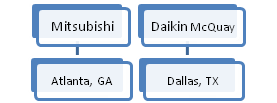New HVAC Hotel and Apartment Technology Obtains Large EPAct Tax Incentives
New HVAC technology called VRV (Variable Refrigerant Volume system), also known as VRF (Variable Refrigerant Flow), is substantially reducing hotel and apartment building energy expenses.
This new technology began to mainstream into the U.S. market after the enactment of the Energy Policy Act and is now being widely recommended by the architecture, engineering, and HVAC industries.
The EPAct Section 179D Tax Opportunities
Pursuant to Energy Policy Act (EPAct) Section 179D, VRV building owners making qualifying energy-reducing investments in their new or existing locations can obtain immediate tax deductions of up to $1.80 per square foot.If the building project doesn't qualify for the maximum EPAct Section 179D $1.80 per square foot immediate tax deduction, there are tax deductions of up to $0.60 per square foot for each of the three major building subsystems: lighting, HVAC (heating, ventilating, and air conditioning), and the building envelope. The building envelope is every item on the building’s exterior perimeter that touches the outside world including roof, walls, insulation, doors, windows and foundation.
VRV Technology Description
VRF/VRV is an air conditioning system most efficient for commercial buildings because of the ability to individualize control for different zones/rooms, whereas conventional systems condition a building as a whole. The system is very beneficial for buildings with varying cooling needs and different zones.In particular, hotels, apartments, schools, and office buildings would get the most benefit from this system as individuals want to be able to control the temperature in their area. Individual control in VRF/VRV systems creates energy efficiency and allows for flexibility in building design.
The Japanese Manufacturers
First utilized in Japan over 20 years ago, VRF/VFV units are now marketed in the U.S. by two large Japanese manufacturers, namely Mitsubishi and Daikin McQuay. As new entrants, both companies chose to locate their U.S. headquarters in two major warmer temperature markets, utilizing large amounts of cooling, namely Dallas, Texas and Atlanta, Georgia.
Apartment HVAC ReplacementWith apartments it is the tenant that bares the utility costs related to HVAC. New benchmarking rules in major apartment markets, including California, New York City, Washington, D.C., Austin, and Seattle, will soon provide large amounts of data related to current apartment energy costs.
Presumably the Atlanta and Dallas markets where the two U.S. VRF/VRV sellers are headquartered will quickly become aware of the magnitude of energy savings.
Hotel HVAC Tax Savings
The timing for this cost saving technology is excellent for the hotel category since the industry is in the midst of a rapid economic recovery. The hotel industry was decimated during the economic downturn and has since reorganized.During the economic downturn necessary HVAC replacements were defined and are now being addressed. Often hotel investment groups own multiple properties so if they are pleased with VRF/VRV technology incentives, they will replicate it across their hotel portfolio.
Substantial Energy Cost Savings
For both hotels and apartments building HVAC is the largest energy cost item. VRF/VRV’s will annually reduce total energy costs for these two markets by at least 20% and may reduce current building energy cost by as much as 40%.Many hotels and apartment buildings are currently installing LED and other energy efficient light technologies and the total energy cost savings from both measures can often exceed 50%.